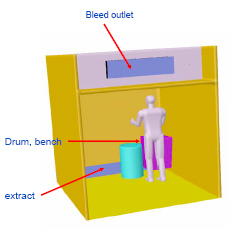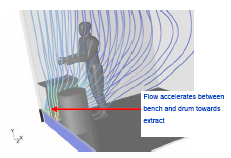1. Introduction.
Design principles for containment equipment are not new. The early nuclear and biological industries had to develop safe systems for handling very hazardous materials.
Figure 1: Geometry of laminar flow booth.
As the manufacture of ever more potent and toxic pharmaceuticals grows, so does the need for employee and workplace protection. Rose Consulting Engineers Limited (RCEL) have applied their experience from the nuclear industry to the design and development of such laminar flow booths, using Computational Fluid Dynamics (CFD).
2. The Model
A full 3D computer model is built, see Figure 1, and the operating conditions such as flows, temperatures and pressures are applied to this engineering model. Commercial CFD software is used to solve the Navier Stokes equations of fluid flow and the results are then post-processed in order to give information regarding the performance and suitability of the design.
|
Figure 2: Velocity coloured pathlines.
3. The Result
Figure 2 shows the distribution of air velocity around an operator stood in front of a work bench and drum. The work bench is a unique design, having perforations in the top and side surfaces. The pathlines are coloured by velocity and can be seen to pass, undisturbed, through the top of the work bench and also accelerating between the bench and the drum.
A good design needs to keep the booth atmosphere clean but not interfere with the process operations. These results show the flow to descend smoothly past the operator and through to the extract. CFD allows the designer to interrogate the internal flows for any unwanted turbulence or dead spots.
4. Conclusion
The use of this modelling tool quickly allows an assessment of the design and saves costs by reducing the amount of prototypes that need to be built and tested.
Further, the range of quantitative data available from the CFD models provides much more information to the designer, compared with that gained from smoke or other flow visualisation experiments.
|
![[IMAGE] Site Location](../img/consulting.gif)

